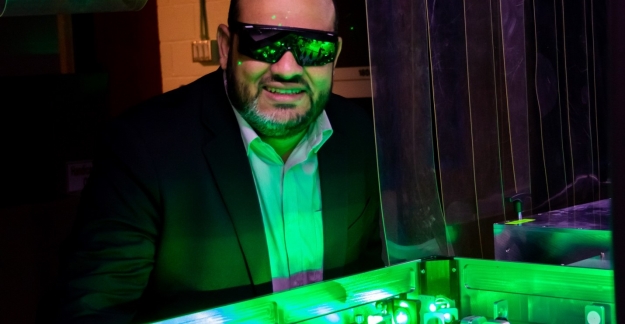Optical switching at file speeds opens door for ultrafast, light-based electronics and computer systems College of Arizona physicists led a world group in reaching optical switching of a light-weight sign at attosecond speeds to succeed in beforehand unattainable knowledge switch speeds. An attosecond is one quintillionth of a second.
By Logan Burtch-Buus, College Communications
Mohammed Hassan College of Arizona Assistant Professor of Physics and Optical Sciences Mohammed Hassan Mohammed Hassan
Think about a house pc working 1 million instances quicker than the most costly {hardware} available on the market. Now, think about that stage of computing energy because the trade customary. College of Arizona researchers hope to pave the way in which for that actuality utilizing light-based optical computing, a marked enchancment from the semiconductor-based transistors that presently run the world.
“Semiconductor-based transistors are in the entire electronics that we use right this moment,” stated Mohammed Hassan, assistant professor of physics and optical sciences. “They’re a part of each trade – from children’ toys to rockets – and are the primary constructing blocks of electronics.”
Hassan lad a world group of researchers that revealed the analysis article “Ultrafast optical switching and knowledge encoding on synthesized gentle fields” in Science Advances in February. UArizona physics postdoctoral analysis affiliate Dandan Hui and physics graduate pupil Husain Alqattan additionally contributed to the article, along with researchers from Ohio State College and the Ludwig Maximilian College of Munich.
Semiconductors in electronics depend on electrical alerts transmitted through microwaves to modify – both enable or stop – the stream of electrical energy and knowledge, represented as both “on” or “off.” Hassan stated the way forward for electronics will likely be based mostly as a substitute on utilizing laser gentle to regulate electrical alerts, opening the door for the institution of “optical transistors” and the event of ultrafast optical electronics.
For the reason that invention of semiconductor transistors within the Nineteen Forties, technological development has centered on growing the velocity at which electrical alerts might be generated – measured in hertz. In keeping with Hassan, the quickest semiconductor transistors on this planet can function at a velocity of greater than 800 gigahertz. Knowledge switch at that frequency is measured at a scale of picoseconds, or one trillionth of a second.
Pc processing energy has elevated steadily because the introduction of the semiconductor transistor, although Hassan stated one of many main considerations in creating quicker expertise is that the warmth generated by persevering with so as to add transistors to a microchip would finally require extra power to chill than can move via the chip.
Of their article, Hassan and his collaborators focus on utilizing all-optical switching of a light-weight sign on and off to succeed in knowledge switch speeds exceeding a petahertz, measured on the attosecond time scale. An attosecond is one quintillionth of a second, that means the switch of information 1 million instances quicker than the quickest semiconductor transistors.
Whereas optical switches have been already proven to realize data processing speeds quicker than that of semiconductor transistor-based expertise, Hassan and his co-authors have been in a position to register the on and off alerts from a light-weight supply occurring on the scale of billionths of a second. This was achieved by profiting from a attribute of fused silica, a glass typically utilized in optics. Fused silica can instantaneously change its reflectivity, and through the use of ultrafast lasers, Hassan and his group have been in a position to register adjustments in a light-weight’s sign on the attosecond time scale. The work additionally demonstrated the opportunity of sending knowledge within the type of “one” and “zero” representing on and off through gentle at beforehand unattainable speeds.
“This new development would additionally enable the encoding of information on ultrafast laser pulses, which might enhance the info switch velocity and may very well be utilized in long-distance communications from Earth into deep house,” Hassan stated. “This guarantees to extend the limiting velocity of information processing and data encoding and open a brand new realm of knowledge expertise.”
The venture was funded by a $1.4 million grant awarded to Hassan in 2018 by the Gordon and Betty Moore Basis, a corporation that goals “to create optimistic outcomes for future generations” by supporting analysis into scientific discovery, environmental conservation and affected person care. The article was additionally based mostly on work supported by the USA Air Drive Workplace of Scientific Analysis’s Younger Investigator Analysis Program.
Additional data A video clarification of the venture might be discovered on YouTube.
Share
